Exploring Depreciation Methods and Their Impact on Financial Reporting
VerifiedAdded on 2020/05/28
|10
|3125
|89
Essay
AI Summary
The essay delves into the strategic application of various depreciation techniques within corporate financial management, focusing on their effects on profit reporting and asset valuation over time. By analyzing different depreciation methods such as straight-line and accelerated depreciation, it highlights how these choices can significantly impact a company's financial statements and future economic benefits from assets. The discussion includes an exploration of ethical considerations when altering depreciation methods for financial advantage, using a case study to illustrate the potential implications on profit margins and asset valuation.
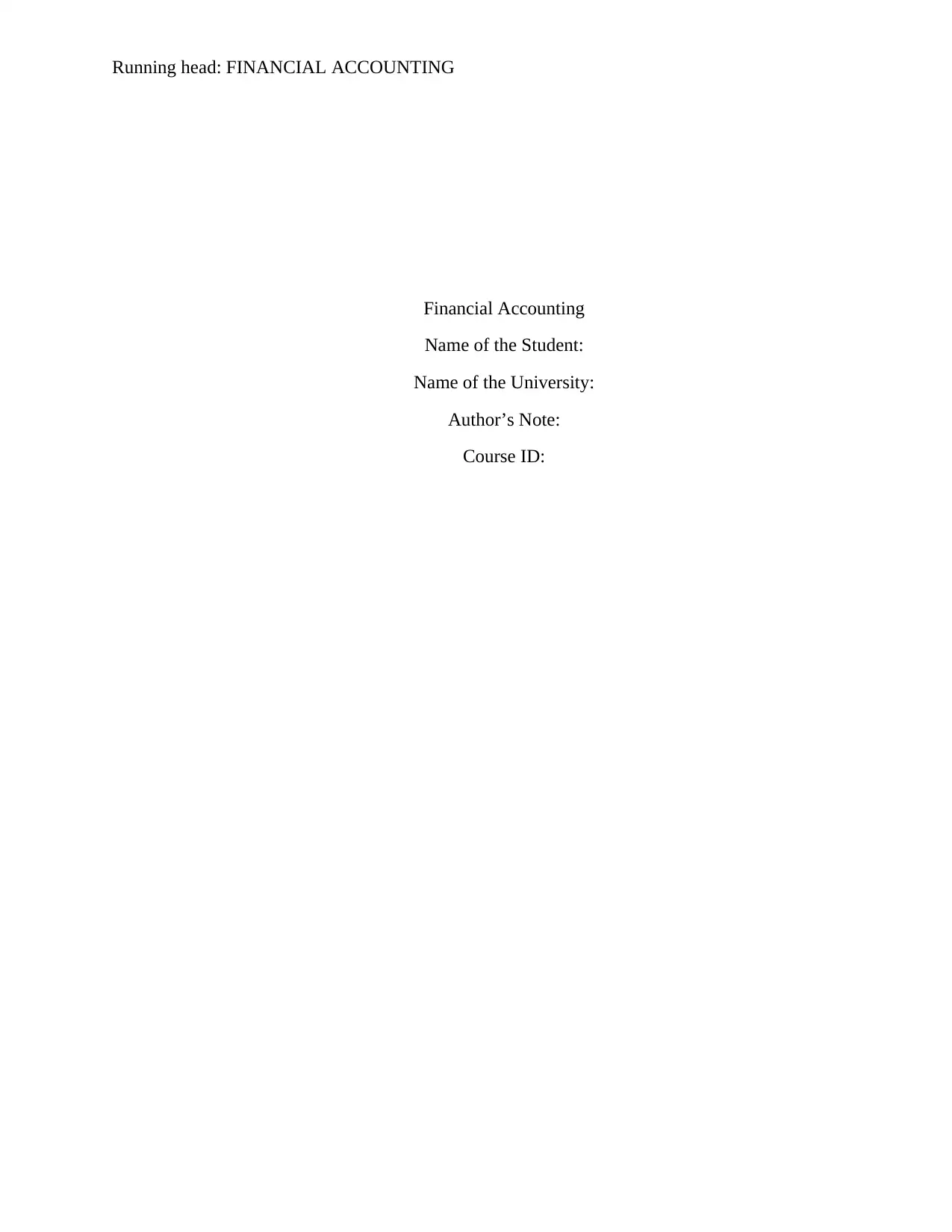
Running head: FINANCIAL ACCOUNTING
Financial Accounting
Name of the Student:
Name of the University:
Author’s Note:
Course ID:
Financial Accounting
Name of the Student:
Name of the University:
Author’s Note:
Course ID:
Paraphrase This Document
Need a fresh take? Get an instant paraphrase of this document with our AI Paraphraser
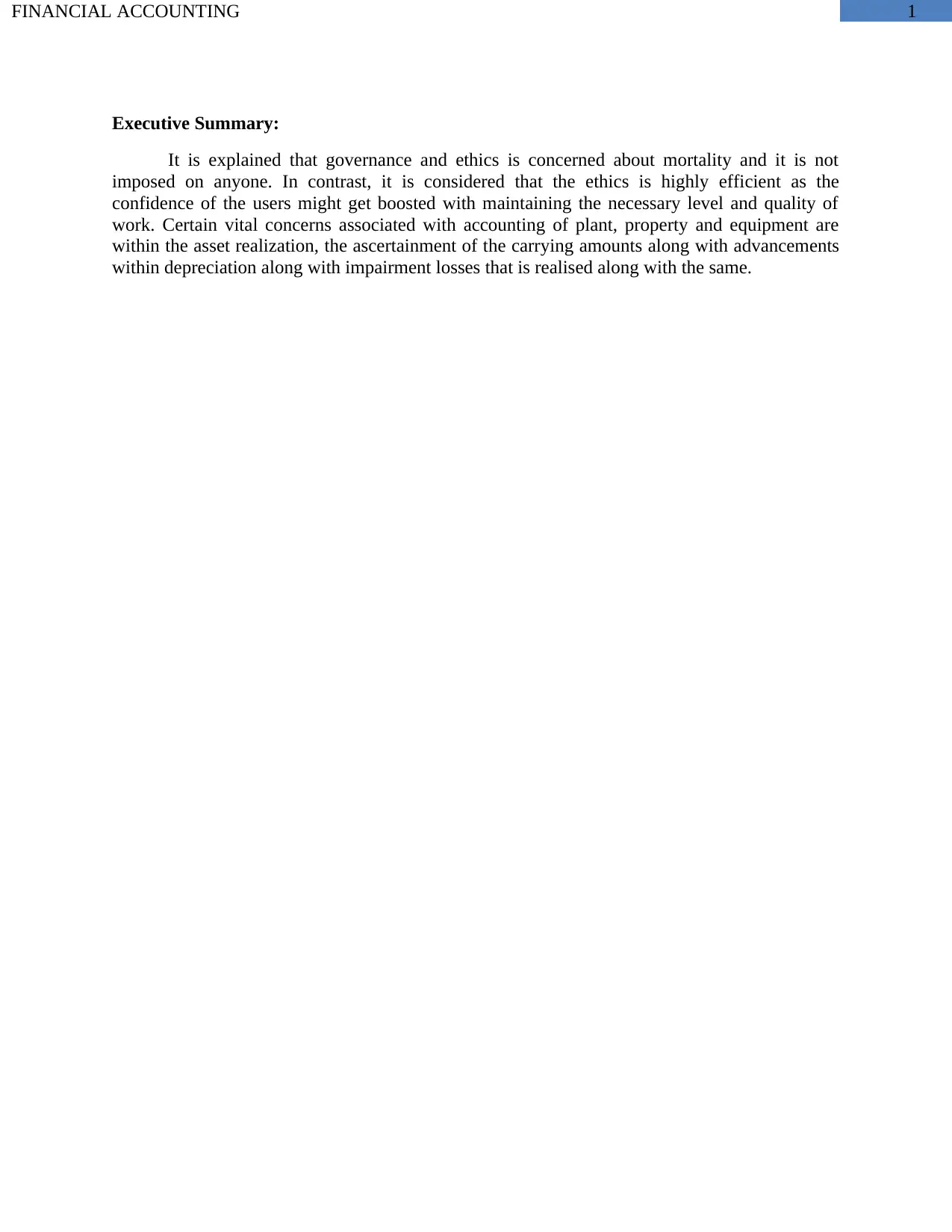
1FINANCIAL ACCOUNTING
Executive Summary:
It is explained that governance and ethics is concerned about mortality and it is not
imposed on anyone. In contrast, it is considered that the ethics is highly efficient as the
confidence of the users might get boosted with maintaining the necessary level and quality of
work. Certain vital concerns associated with accounting of plant, property and equipment are
within the asset realization, the ascertainment of the carrying amounts along with advancements
within depreciation along with impairment losses that is realised along with the same.
Executive Summary:
It is explained that governance and ethics is concerned about mortality and it is not
imposed on anyone. In contrast, it is considered that the ethics is highly efficient as the
confidence of the users might get boosted with maintaining the necessary level and quality of
work. Certain vital concerns associated with accounting of plant, property and equipment are
within the asset realization, the ascertainment of the carrying amounts along with advancements
within depreciation along with impairment losses that is realised along with the same.
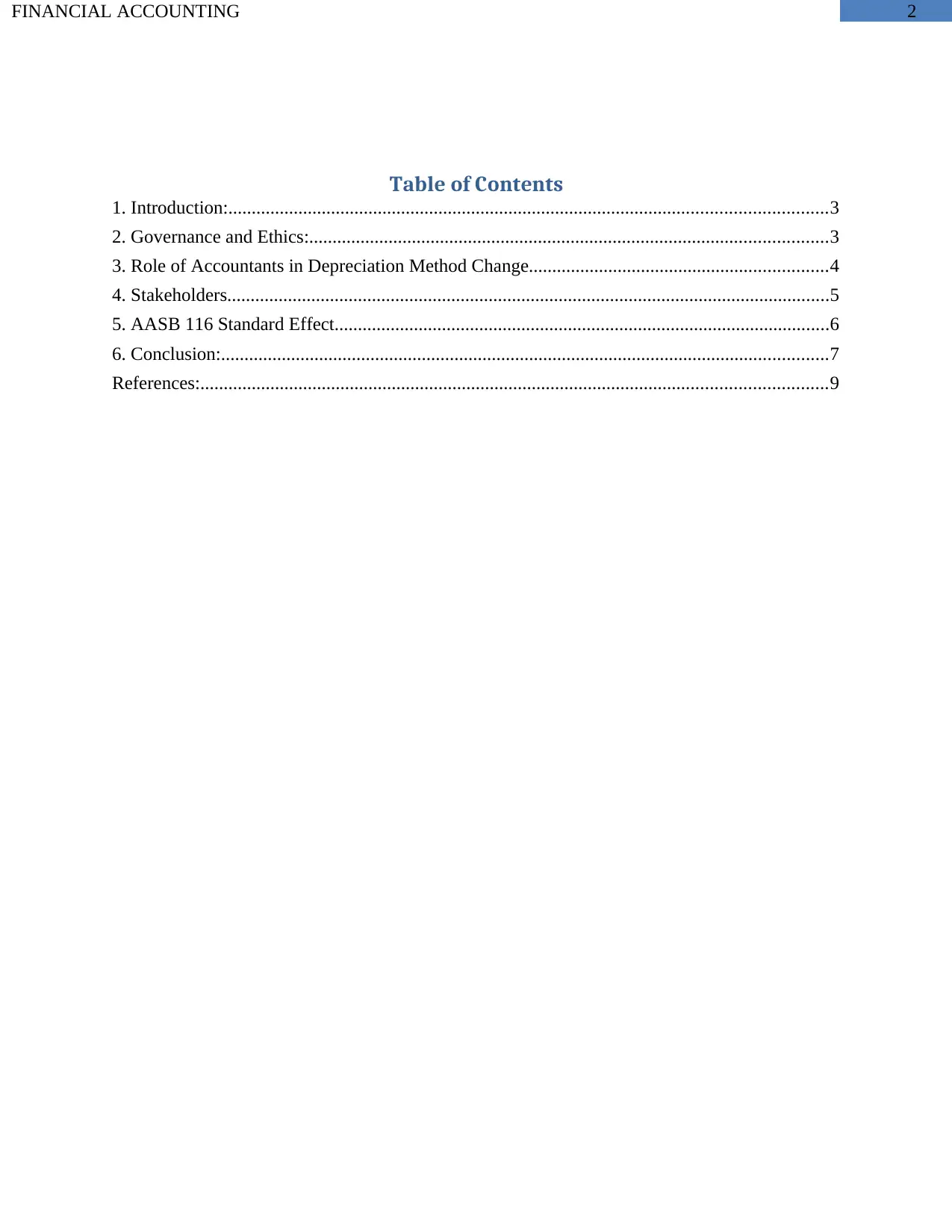
2FINANCIAL ACCOUNTING
Table of Contents
1. Introduction:................................................................................................................................3
2. Governance and Ethics:...............................................................................................................3
3. Role of Accountants in Depreciation Method Change................................................................4
4. Stakeholders.................................................................................................................................5
5. AASB 116 Standard Effect..........................................................................................................6
6. Conclusion:..................................................................................................................................7
References:......................................................................................................................................9
Table of Contents
1. Introduction:................................................................................................................................3
2. Governance and Ethics:...............................................................................................................3
3. Role of Accountants in Depreciation Method Change................................................................4
4. Stakeholders.................................................................................................................................5
5. AASB 116 Standard Effect..........................................................................................................6
6. Conclusion:..................................................................................................................................7
References:......................................................................................................................................9
⊘ This is a preview!⊘
Do you want full access?
Subscribe today to unlock all pages.

Trusted by 1+ million students worldwide
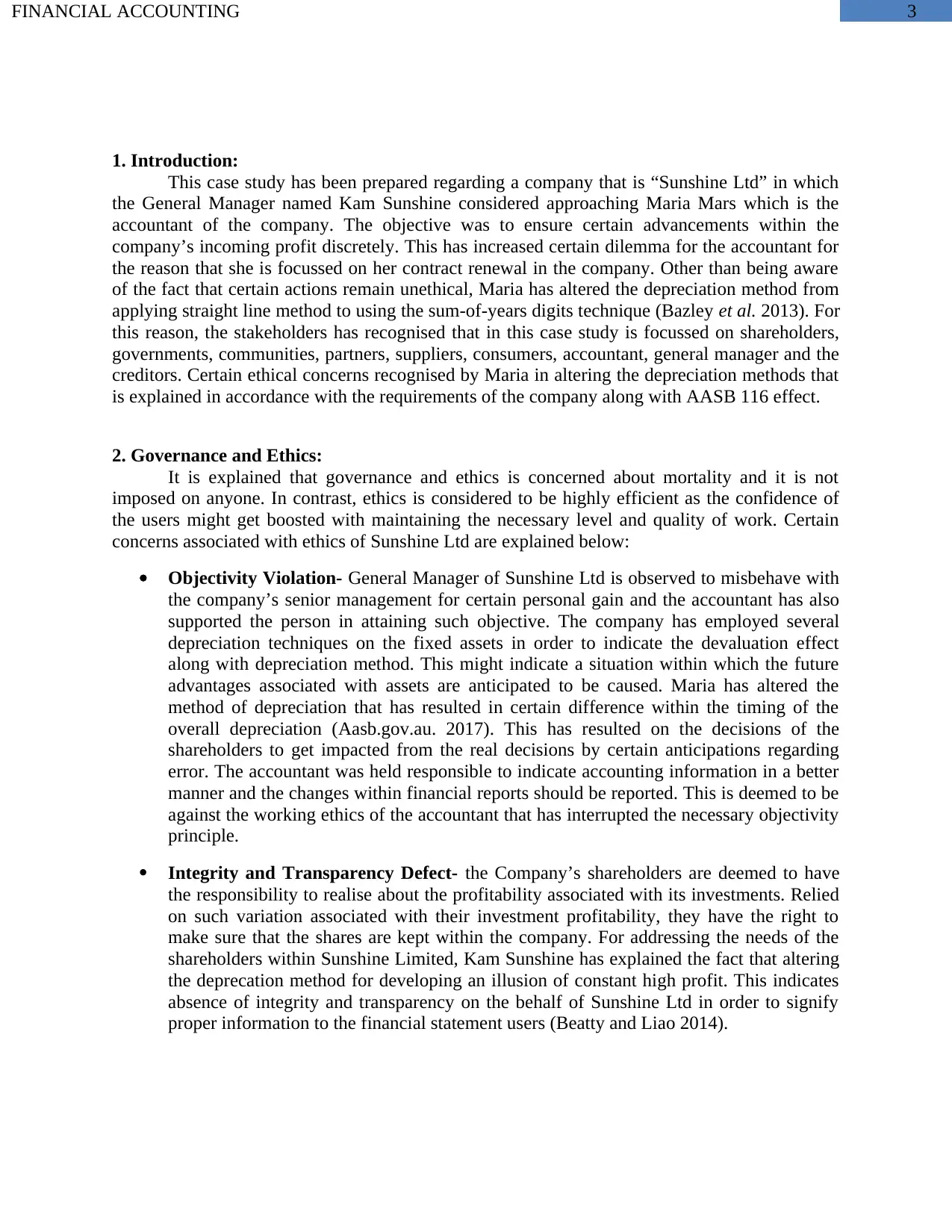
3FINANCIAL ACCOUNTING
1. Introduction:
This case study has been prepared regarding a company that is “Sunshine Ltd” in which
the General Manager named Kam Sunshine considered approaching Maria Mars which is the
accountant of the company. The objective was to ensure certain advancements within the
company’s incoming profit discretely. This has increased certain dilemma for the accountant for
the reason that she is focussed on her contract renewal in the company. Other than being aware
of the fact that certain actions remain unethical, Maria has altered the depreciation method from
applying straight line method to using the sum-of-years digits technique (Bazley et al. 2013). For
this reason, the stakeholders has recognised that in this case study is focussed on shareholders,
governments, communities, partners, suppliers, consumers, accountant, general manager and the
creditors. Certain ethical concerns recognised by Maria in altering the depreciation methods that
is explained in accordance with the requirements of the company along with AASB 116 effect.
2. Governance and Ethics:
It is explained that governance and ethics is concerned about mortality and it is not
imposed on anyone. In contrast, ethics is considered to be highly efficient as the confidence of
the users might get boosted with maintaining the necessary level and quality of work. Certain
concerns associated with ethics of Sunshine Ltd are explained below:
Objectivity Violation- General Manager of Sunshine Ltd is observed to misbehave with
the company’s senior management for certain personal gain and the accountant has also
supported the person in attaining such objective. The company has employed several
depreciation techniques on the fixed assets in order to indicate the devaluation effect
along with depreciation method. This might indicate a situation within which the future
advantages associated with assets are anticipated to be caused. Maria has altered the
method of depreciation that has resulted in certain difference within the timing of the
overall depreciation (Aasb.gov.au. 2017). This has resulted on the decisions of the
shareholders to get impacted from the real decisions by certain anticipations regarding
error. The accountant was held responsible to indicate accounting information in a better
manner and the changes within financial reports should be reported. This is deemed to be
against the working ethics of the accountant that has interrupted the necessary objectivity
principle.
Integrity and Transparency Defect- the Company’s shareholders are deemed to have
the responsibility to realise about the profitability associated with its investments. Relied
on such variation associated with their investment profitability, they have the right to
make sure that the shares are kept within the company. For addressing the needs of the
shareholders within Sunshine Limited, Kam Sunshine has explained the fact that altering
the deprecation method for developing an illusion of constant high profit. This indicates
absence of integrity and transparency on the behalf of Sunshine Ltd in order to signify
proper information to the financial statement users (Beatty and Liao 2014).
1. Introduction:
This case study has been prepared regarding a company that is “Sunshine Ltd” in which
the General Manager named Kam Sunshine considered approaching Maria Mars which is the
accountant of the company. The objective was to ensure certain advancements within the
company’s incoming profit discretely. This has increased certain dilemma for the accountant for
the reason that she is focussed on her contract renewal in the company. Other than being aware
of the fact that certain actions remain unethical, Maria has altered the depreciation method from
applying straight line method to using the sum-of-years digits technique (Bazley et al. 2013). For
this reason, the stakeholders has recognised that in this case study is focussed on shareholders,
governments, communities, partners, suppliers, consumers, accountant, general manager and the
creditors. Certain ethical concerns recognised by Maria in altering the depreciation methods that
is explained in accordance with the requirements of the company along with AASB 116 effect.
2. Governance and Ethics:
It is explained that governance and ethics is concerned about mortality and it is not
imposed on anyone. In contrast, ethics is considered to be highly efficient as the confidence of
the users might get boosted with maintaining the necessary level and quality of work. Certain
concerns associated with ethics of Sunshine Ltd are explained below:
Objectivity Violation- General Manager of Sunshine Ltd is observed to misbehave with
the company’s senior management for certain personal gain and the accountant has also
supported the person in attaining such objective. The company has employed several
depreciation techniques on the fixed assets in order to indicate the devaluation effect
along with depreciation method. This might indicate a situation within which the future
advantages associated with assets are anticipated to be caused. Maria has altered the
method of depreciation that has resulted in certain difference within the timing of the
overall depreciation (Aasb.gov.au. 2017). This has resulted on the decisions of the
shareholders to get impacted from the real decisions by certain anticipations regarding
error. The accountant was held responsible to indicate accounting information in a better
manner and the changes within financial reports should be reported. This is deemed to be
against the working ethics of the accountant that has interrupted the necessary objectivity
principle.
Integrity and Transparency Defect- the Company’s shareholders are deemed to have
the responsibility to realise about the profitability associated with its investments. Relied
on such variation associated with their investment profitability, they have the right to
make sure that the shares are kept within the company. For addressing the needs of the
shareholders within Sunshine Limited, Kam Sunshine has explained the fact that altering
the deprecation method for developing an illusion of constant high profit. This indicates
absence of integrity and transparency on the behalf of Sunshine Ltd in order to signify
proper information to the financial statement users (Beatty and Liao 2014).
Paraphrase This Document
Need a fresh take? Get an instant paraphrase of this document with our AI Paraphraser
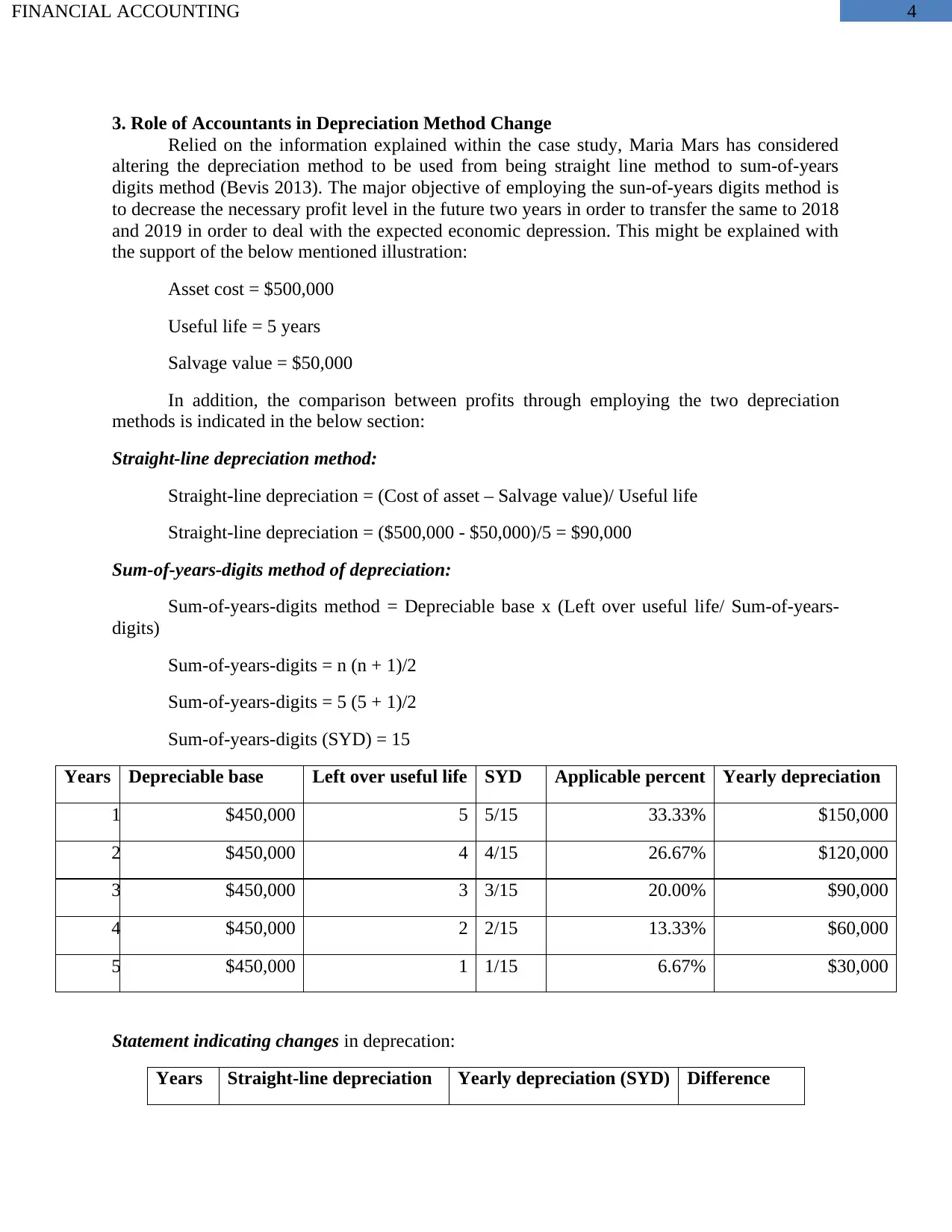
4FINANCIAL ACCOUNTING
3. Role of Accountants in Depreciation Method Change
Relied on the information explained within the case study, Maria Mars has considered
altering the depreciation method to be used from being straight line method to sum-of-years
digits method (Bevis 2013). The major objective of employing the sun-of-years digits method is
to decrease the necessary profit level in the future two years in order to transfer the same to 2018
and 2019 in order to deal with the expected economic depression. This might be explained with
the support of the below mentioned illustration:
Asset cost = $500,000
Useful life = 5 years
Salvage value = $50,000
In addition, the comparison between profits through employing the two depreciation
methods is indicated in the below section:
Straight-line depreciation method:
Straight-line depreciation = (Cost of asset – Salvage value)/ Useful life
Straight-line depreciation = ($500,000 - $50,000)/5 = $90,000
Sum-of-years-digits method of depreciation:
Sum-of-years-digits method = Depreciable base x (Left over useful life/ Sum-of-years-
digits)
Sum-of-years-digits = n (n + 1)/2
Sum-of-years-digits = 5 (5 + 1)/2
Sum-of-years-digits (SYD) = 15
Years Depreciable base Left over useful life SYD Applicable percent Yearly depreciation
1 $450,000 5 5/15 33.33% $150,000
2 $450,000 4 4/15 26.67% $120,000
3 $450,000 3 3/15 20.00% $90,000
4 $450,000 2 2/15 13.33% $60,000
5 $450,000 1 1/15 6.67% $30,000
Statement indicating changes in deprecation:
Years Straight-line depreciation Yearly depreciation (SYD) Difference
3. Role of Accountants in Depreciation Method Change
Relied on the information explained within the case study, Maria Mars has considered
altering the depreciation method to be used from being straight line method to sum-of-years
digits method (Bevis 2013). The major objective of employing the sun-of-years digits method is
to decrease the necessary profit level in the future two years in order to transfer the same to 2018
and 2019 in order to deal with the expected economic depression. This might be explained with
the support of the below mentioned illustration:
Asset cost = $500,000
Useful life = 5 years
Salvage value = $50,000
In addition, the comparison between profits through employing the two depreciation
methods is indicated in the below section:
Straight-line depreciation method:
Straight-line depreciation = (Cost of asset – Salvage value)/ Useful life
Straight-line depreciation = ($500,000 - $50,000)/5 = $90,000
Sum-of-years-digits method of depreciation:
Sum-of-years-digits method = Depreciable base x (Left over useful life/ Sum-of-years-
digits)
Sum-of-years-digits = n (n + 1)/2
Sum-of-years-digits = 5 (5 + 1)/2
Sum-of-years-digits (SYD) = 15
Years Depreciable base Left over useful life SYD Applicable percent Yearly depreciation
1 $450,000 5 5/15 33.33% $150,000
2 $450,000 4 4/15 26.67% $120,000
3 $450,000 3 3/15 20.00% $90,000
4 $450,000 2 2/15 13.33% $60,000
5 $450,000 1 1/15 6.67% $30,000
Statement indicating changes in deprecation:
Years Straight-line depreciation Yearly depreciation (SYD) Difference
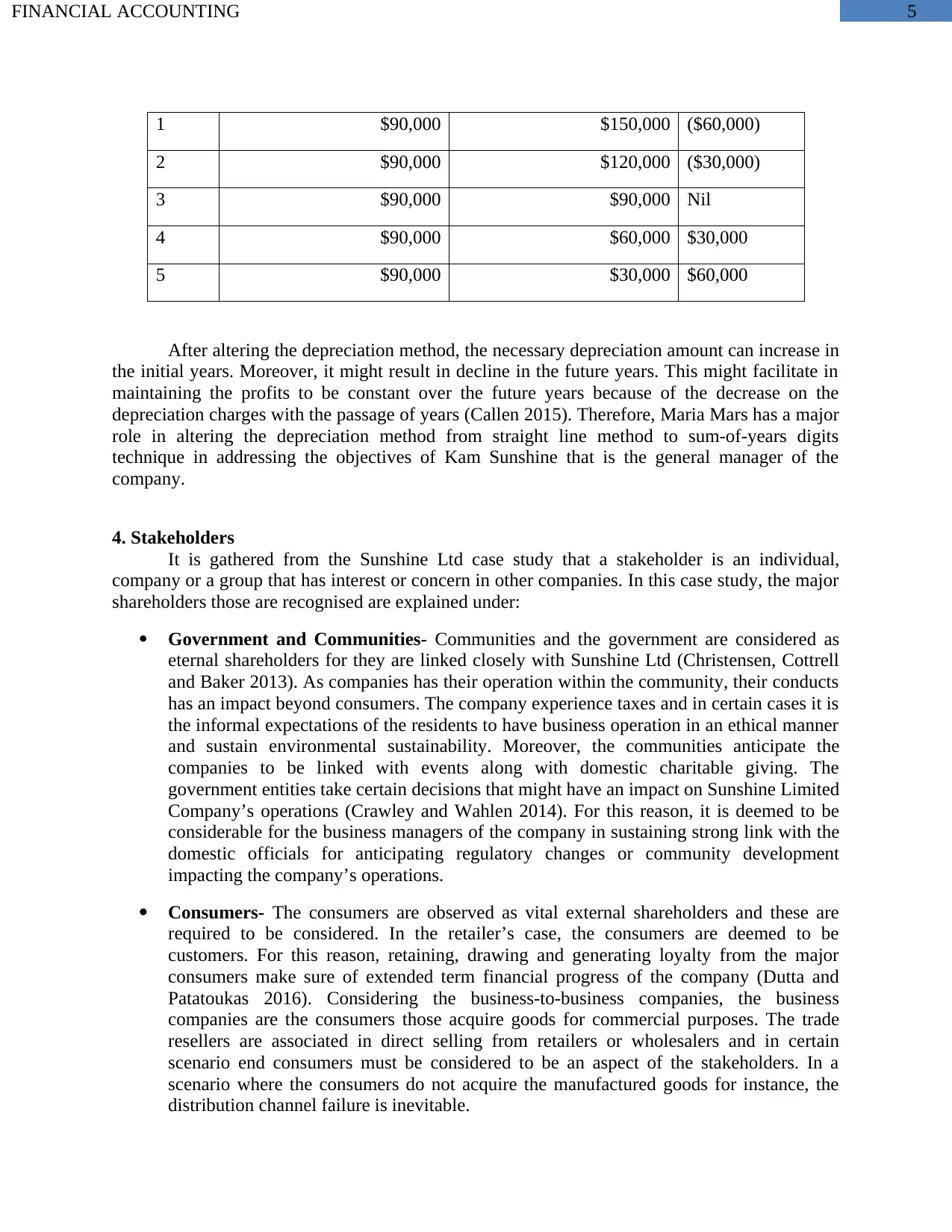
5FINANCIAL ACCOUNTING
1 $90,000 $150,000 ($60,000)
2 $90,000 $120,000 ($30,000)
3 $90,000 $90,000 Nil
4 $90,000 $60,000 $30,000
5 $90,000 $30,000 $60,000
After altering the depreciation method, the necessary depreciation amount can increase in
the initial years. Moreover, it might result in decline in the future years. This might facilitate in
maintaining the profits to be constant over the future years because of the decrease on the
depreciation charges with the passage of years (Callen 2015). Therefore, Maria Mars has a major
role in altering the depreciation method from straight line method to sum-of-years digits
technique in addressing the objectives of Kam Sunshine that is the general manager of the
company.
4. Stakeholders
It is gathered from the Sunshine Ltd case study that a stakeholder is an individual,
company or a group that has interest or concern in other companies. In this case study, the major
shareholders those are recognised are explained under:
Government and Communities- Communities and the government are considered as
eternal shareholders for they are linked closely with Sunshine Ltd (Christensen, Cottrell
and Baker 2013). As companies has their operation within the community, their conducts
has an impact beyond consumers. The company experience taxes and in certain cases it is
the informal expectations of the residents to have business operation in an ethical manner
and sustain environmental sustainability. Moreover, the communities anticipate the
companies to be linked with events along with domestic charitable giving. The
government entities take certain decisions that might have an impact on Sunshine Limited
Company’s operations (Crawley and Wahlen 2014). For this reason, it is deemed to be
considerable for the business managers of the company in sustaining strong link with the
domestic officials for anticipating regulatory changes or community development
impacting the company’s operations.
Consumers- The consumers are observed as vital external shareholders and these are
required to be considered. In the retailer’s case, the consumers are deemed to be
customers. For this reason, retaining, drawing and generating loyalty from the major
consumers make sure of extended term financial progress of the company (Dutta and
Patatoukas 2016). Considering the business-to-business companies, the business
companies are the consumers those acquire goods for commercial purposes. The trade
resellers are associated in direct selling from retailers or wholesalers and in certain
scenario end consumers must be considered to be an aspect of the stakeholders. In a
scenario where the consumers do not acquire the manufactured goods for instance, the
distribution channel failure is inevitable.
1 $90,000 $150,000 ($60,000)
2 $90,000 $120,000 ($30,000)
3 $90,000 $90,000 Nil
4 $90,000 $60,000 $30,000
5 $90,000 $30,000 $60,000
After altering the depreciation method, the necessary depreciation amount can increase in
the initial years. Moreover, it might result in decline in the future years. This might facilitate in
maintaining the profits to be constant over the future years because of the decrease on the
depreciation charges with the passage of years (Callen 2015). Therefore, Maria Mars has a major
role in altering the depreciation method from straight line method to sum-of-years digits
technique in addressing the objectives of Kam Sunshine that is the general manager of the
company.
4. Stakeholders
It is gathered from the Sunshine Ltd case study that a stakeholder is an individual,
company or a group that has interest or concern in other companies. In this case study, the major
shareholders those are recognised are explained under:
Government and Communities- Communities and the government are considered as
eternal shareholders for they are linked closely with Sunshine Ltd (Christensen, Cottrell
and Baker 2013). As companies has their operation within the community, their conducts
has an impact beyond consumers. The company experience taxes and in certain cases it is
the informal expectations of the residents to have business operation in an ethical manner
and sustain environmental sustainability. Moreover, the communities anticipate the
companies to be linked with events along with domestic charitable giving. The
government entities take certain decisions that might have an impact on Sunshine Limited
Company’s operations (Crawley and Wahlen 2014). For this reason, it is deemed to be
considerable for the business managers of the company in sustaining strong link with the
domestic officials for anticipating regulatory changes or community development
impacting the company’s operations.
Consumers- The consumers are observed as vital external shareholders and these are
required to be considered. In the retailer’s case, the consumers are deemed to be
customers. For this reason, retaining, drawing and generating loyalty from the major
consumers make sure of extended term financial progress of the company (Dutta and
Patatoukas 2016). Considering the business-to-business companies, the business
companies are the consumers those acquire goods for commercial purposes. The trade
resellers are associated in direct selling from retailers or wholesalers and in certain
scenario end consumers must be considered to be an aspect of the stakeholders. In a
scenario where the consumers do not acquire the manufactured goods for instance, the
distribution channel failure is inevitable.
⊘ This is a preview!⊘
Do you want full access?
Subscribe today to unlock all pages.

Trusted by 1+ million students worldwide
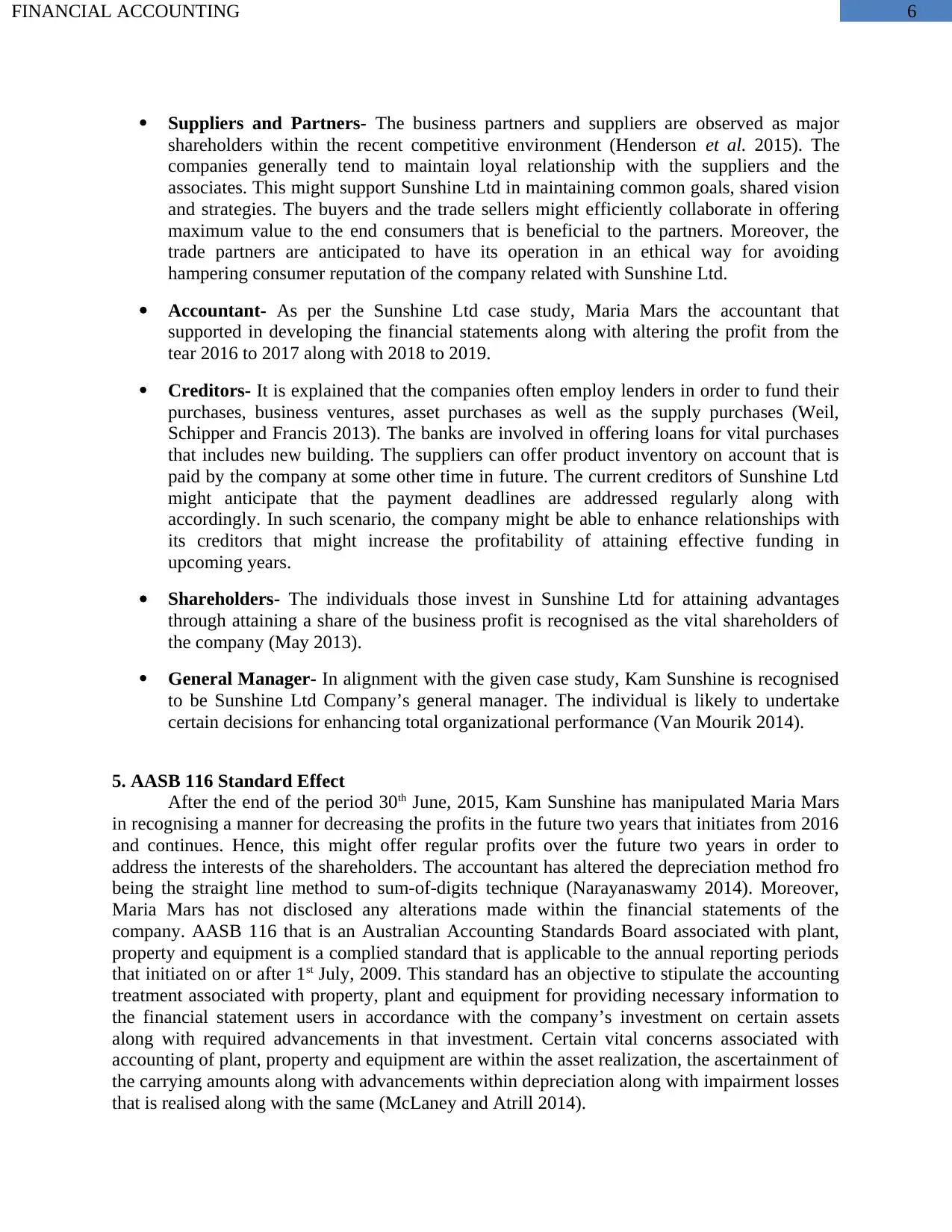
6FINANCIAL ACCOUNTING
Suppliers and Partners- The business partners and suppliers are observed as major
shareholders within the recent competitive environment (Henderson et al. 2015). The
companies generally tend to maintain loyal relationship with the suppliers and the
associates. This might support Sunshine Ltd in maintaining common goals, shared vision
and strategies. The buyers and the trade sellers might efficiently collaborate in offering
maximum value to the end consumers that is beneficial to the partners. Moreover, the
trade partners are anticipated to have its operation in an ethical way for avoiding
hampering consumer reputation of the company related with Sunshine Ltd.
Accountant- As per the Sunshine Ltd case study, Maria Mars the accountant that
supported in developing the financial statements along with altering the profit from the
tear 2016 to 2017 along with 2018 to 2019.
Creditors- It is explained that the companies often employ lenders in order to fund their
purchases, business ventures, asset purchases as well as the supply purchases (Weil,
Schipper and Francis 2013). The banks are involved in offering loans for vital purchases
that includes new building. The suppliers can offer product inventory on account that is
paid by the company at some other time in future. The current creditors of Sunshine Ltd
might anticipate that the payment deadlines are addressed regularly along with
accordingly. In such scenario, the company might be able to enhance relationships with
its creditors that might increase the profitability of attaining effective funding in
upcoming years.
Shareholders- The individuals those invest in Sunshine Ltd for attaining advantages
through attaining a share of the business profit is recognised as the vital shareholders of
the company (May 2013).
General Manager- In alignment with the given case study, Kam Sunshine is recognised
to be Sunshine Ltd Company’s general manager. The individual is likely to undertake
certain decisions for enhancing total organizational performance (Van Mourik 2014).
5. AASB 116 Standard Effect
After the end of the period 30th June, 2015, Kam Sunshine has manipulated Maria Mars
in recognising a manner for decreasing the profits in the future two years that initiates from 2016
and continues. Hence, this might offer regular profits over the future two years in order to
address the interests of the shareholders. The accountant has altered the depreciation method fro
being the straight line method to sum-of-digits technique (Narayanaswamy 2014). Moreover,
Maria Mars has not disclosed any alterations made within the financial statements of the
company. AASB 116 that is an Australian Accounting Standards Board associated with plant,
property and equipment is a complied standard that is applicable to the annual reporting periods
that initiated on or after 1st July, 2009. This standard has an objective to stipulate the accounting
treatment associated with property, plant and equipment for providing necessary information to
the financial statement users in accordance with the company’s investment on certain assets
along with required advancements in that investment. Certain vital concerns associated with
accounting of plant, property and equipment are within the asset realization, the ascertainment of
the carrying amounts along with advancements within depreciation along with impairment losses
that is realised along with the same (McLaney and Atrill 2014).
Suppliers and Partners- The business partners and suppliers are observed as major
shareholders within the recent competitive environment (Henderson et al. 2015). The
companies generally tend to maintain loyal relationship with the suppliers and the
associates. This might support Sunshine Ltd in maintaining common goals, shared vision
and strategies. The buyers and the trade sellers might efficiently collaborate in offering
maximum value to the end consumers that is beneficial to the partners. Moreover, the
trade partners are anticipated to have its operation in an ethical way for avoiding
hampering consumer reputation of the company related with Sunshine Ltd.
Accountant- As per the Sunshine Ltd case study, Maria Mars the accountant that
supported in developing the financial statements along with altering the profit from the
tear 2016 to 2017 along with 2018 to 2019.
Creditors- It is explained that the companies often employ lenders in order to fund their
purchases, business ventures, asset purchases as well as the supply purchases (Weil,
Schipper and Francis 2013). The banks are involved in offering loans for vital purchases
that includes new building. The suppliers can offer product inventory on account that is
paid by the company at some other time in future. The current creditors of Sunshine Ltd
might anticipate that the payment deadlines are addressed regularly along with
accordingly. In such scenario, the company might be able to enhance relationships with
its creditors that might increase the profitability of attaining effective funding in
upcoming years.
Shareholders- The individuals those invest in Sunshine Ltd for attaining advantages
through attaining a share of the business profit is recognised as the vital shareholders of
the company (May 2013).
General Manager- In alignment with the given case study, Kam Sunshine is recognised
to be Sunshine Ltd Company’s general manager. The individual is likely to undertake
certain decisions for enhancing total organizational performance (Van Mourik 2014).
5. AASB 116 Standard Effect
After the end of the period 30th June, 2015, Kam Sunshine has manipulated Maria Mars
in recognising a manner for decreasing the profits in the future two years that initiates from 2016
and continues. Hence, this might offer regular profits over the future two years in order to
address the interests of the shareholders. The accountant has altered the depreciation method fro
being the straight line method to sum-of-digits technique (Narayanaswamy 2014). Moreover,
Maria Mars has not disclosed any alterations made within the financial statements of the
company. AASB 116 that is an Australian Accounting Standards Board associated with plant,
property and equipment is a complied standard that is applicable to the annual reporting periods
that initiated on or after 1st July, 2009. This standard has an objective to stipulate the accounting
treatment associated with property, plant and equipment for providing necessary information to
the financial statement users in accordance with the company’s investment on certain assets
along with required advancements in that investment. Certain vital concerns associated with
accounting of plant, property and equipment are within the asset realization, the ascertainment of
the carrying amounts along with advancements within depreciation along with impairment losses
that is realised along with the same (McLaney and Atrill 2014).
Paraphrase This Document
Need a fresh take? Get an instant paraphrase of this document with our AI Paraphraser
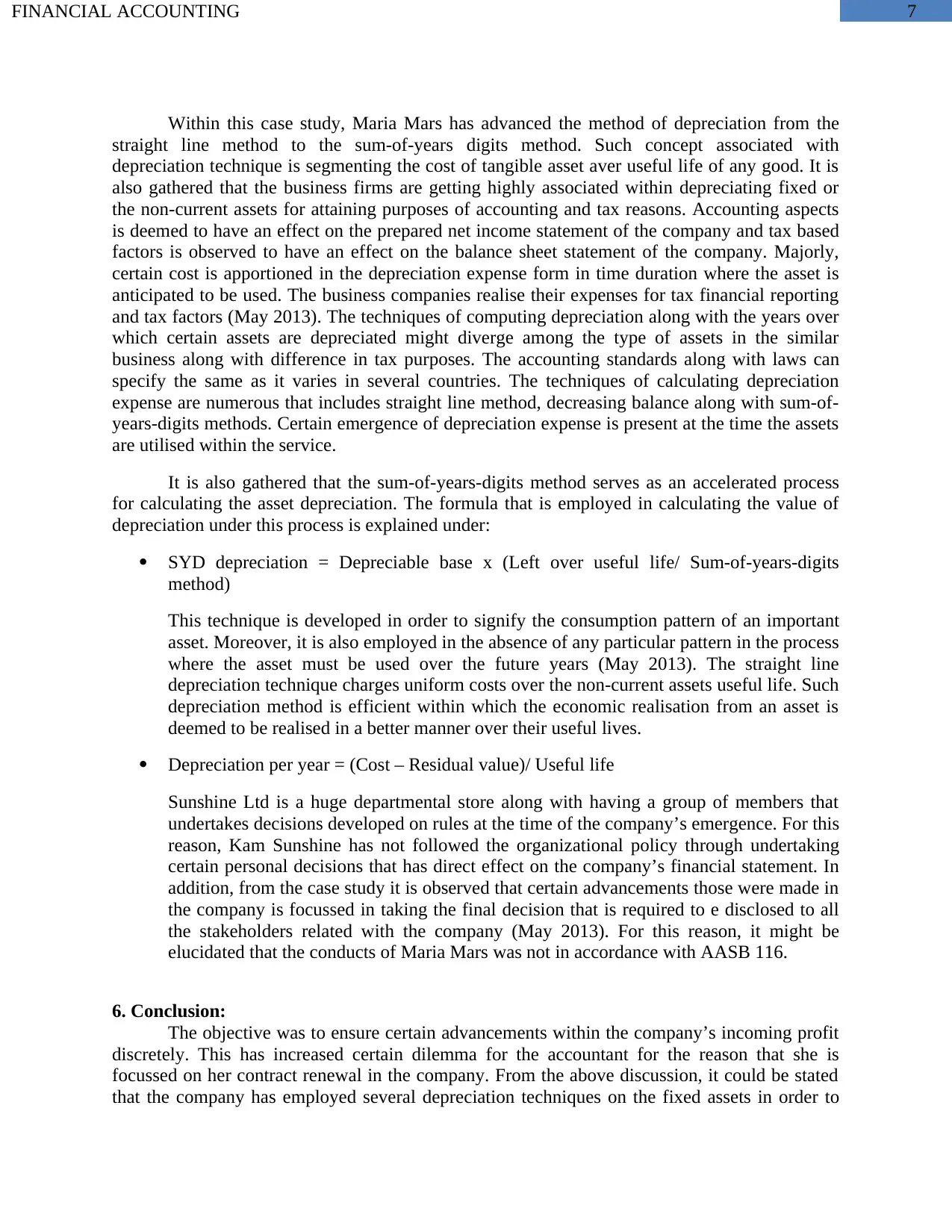
7FINANCIAL ACCOUNTING
Within this case study, Maria Mars has advanced the method of depreciation from the
straight line method to the sum-of-years digits method. Such concept associated with
depreciation technique is segmenting the cost of tangible asset aver useful life of any good. It is
also gathered that the business firms are getting highly associated within depreciating fixed or
the non-current assets for attaining purposes of accounting and tax reasons. Accounting aspects
is deemed to have an effect on the prepared net income statement of the company and tax based
factors is observed to have an effect on the balance sheet statement of the company. Majorly,
certain cost is apportioned in the depreciation expense form in time duration where the asset is
anticipated to be used. The business companies realise their expenses for tax financial reporting
and tax factors (May 2013). The techniques of computing depreciation along with the years over
which certain assets are depreciated might diverge among the type of assets in the similar
business along with difference in tax purposes. The accounting standards along with laws can
specify the same as it varies in several countries. The techniques of calculating depreciation
expense are numerous that includes straight line method, decreasing balance along with sum-of-
years-digits methods. Certain emergence of depreciation expense is present at the time the assets
are utilised within the service.
It is also gathered that the sum-of-years-digits method serves as an accelerated process
for calculating the asset depreciation. The formula that is employed in calculating the value of
depreciation under this process is explained under:
SYD depreciation = Depreciable base x (Left over useful life/ Sum-of-years-digits
method)
This technique is developed in order to signify the consumption pattern of an important
asset. Moreover, it is also employed in the absence of any particular pattern in the process
where the asset must be used over the future years (May 2013). The straight line
depreciation technique charges uniform costs over the non-current assets useful life. Such
depreciation method is efficient within which the economic realisation from an asset is
deemed to be realised in a better manner over their useful lives.
Depreciation per year = (Cost – Residual value)/ Useful life
Sunshine Ltd is a huge departmental store along with having a group of members that
undertakes decisions developed on rules at the time of the company’s emergence. For this
reason, Kam Sunshine has not followed the organizational policy through undertaking
certain personal decisions that has direct effect on the company’s financial statement. In
addition, from the case study it is observed that certain advancements those were made in
the company is focussed in taking the final decision that is required to e disclosed to all
the stakeholders related with the company (May 2013). For this reason, it might be
elucidated that the conducts of Maria Mars was not in accordance with AASB 116.
6. Conclusion:
The objective was to ensure certain advancements within the company’s incoming profit
discretely. This has increased certain dilemma for the accountant for the reason that she is
focussed on her contract renewal in the company. From the above discussion, it could be stated
that the company has employed several depreciation techniques on the fixed assets in order to
Within this case study, Maria Mars has advanced the method of depreciation from the
straight line method to the sum-of-years digits method. Such concept associated with
depreciation technique is segmenting the cost of tangible asset aver useful life of any good. It is
also gathered that the business firms are getting highly associated within depreciating fixed or
the non-current assets for attaining purposes of accounting and tax reasons. Accounting aspects
is deemed to have an effect on the prepared net income statement of the company and tax based
factors is observed to have an effect on the balance sheet statement of the company. Majorly,
certain cost is apportioned in the depreciation expense form in time duration where the asset is
anticipated to be used. The business companies realise their expenses for tax financial reporting
and tax factors (May 2013). The techniques of computing depreciation along with the years over
which certain assets are depreciated might diverge among the type of assets in the similar
business along with difference in tax purposes. The accounting standards along with laws can
specify the same as it varies in several countries. The techniques of calculating depreciation
expense are numerous that includes straight line method, decreasing balance along with sum-of-
years-digits methods. Certain emergence of depreciation expense is present at the time the assets
are utilised within the service.
It is also gathered that the sum-of-years-digits method serves as an accelerated process
for calculating the asset depreciation. The formula that is employed in calculating the value of
depreciation under this process is explained under:
SYD depreciation = Depreciable base x (Left over useful life/ Sum-of-years-digits
method)
This technique is developed in order to signify the consumption pattern of an important
asset. Moreover, it is also employed in the absence of any particular pattern in the process
where the asset must be used over the future years (May 2013). The straight line
depreciation technique charges uniform costs over the non-current assets useful life. Such
depreciation method is efficient within which the economic realisation from an asset is
deemed to be realised in a better manner over their useful lives.
Depreciation per year = (Cost – Residual value)/ Useful life
Sunshine Ltd is a huge departmental store along with having a group of members that
undertakes decisions developed on rules at the time of the company’s emergence. For this
reason, Kam Sunshine has not followed the organizational policy through undertaking
certain personal decisions that has direct effect on the company’s financial statement. In
addition, from the case study it is observed that certain advancements those were made in
the company is focussed in taking the final decision that is required to e disclosed to all
the stakeholders related with the company (May 2013). For this reason, it might be
elucidated that the conducts of Maria Mars was not in accordance with AASB 116.
6. Conclusion:
The objective was to ensure certain advancements within the company’s incoming profit
discretely. This has increased certain dilemma for the accountant for the reason that she is
focussed on her contract renewal in the company. From the above discussion, it could be stated
that the company has employed several depreciation techniques on the fixed assets in order to
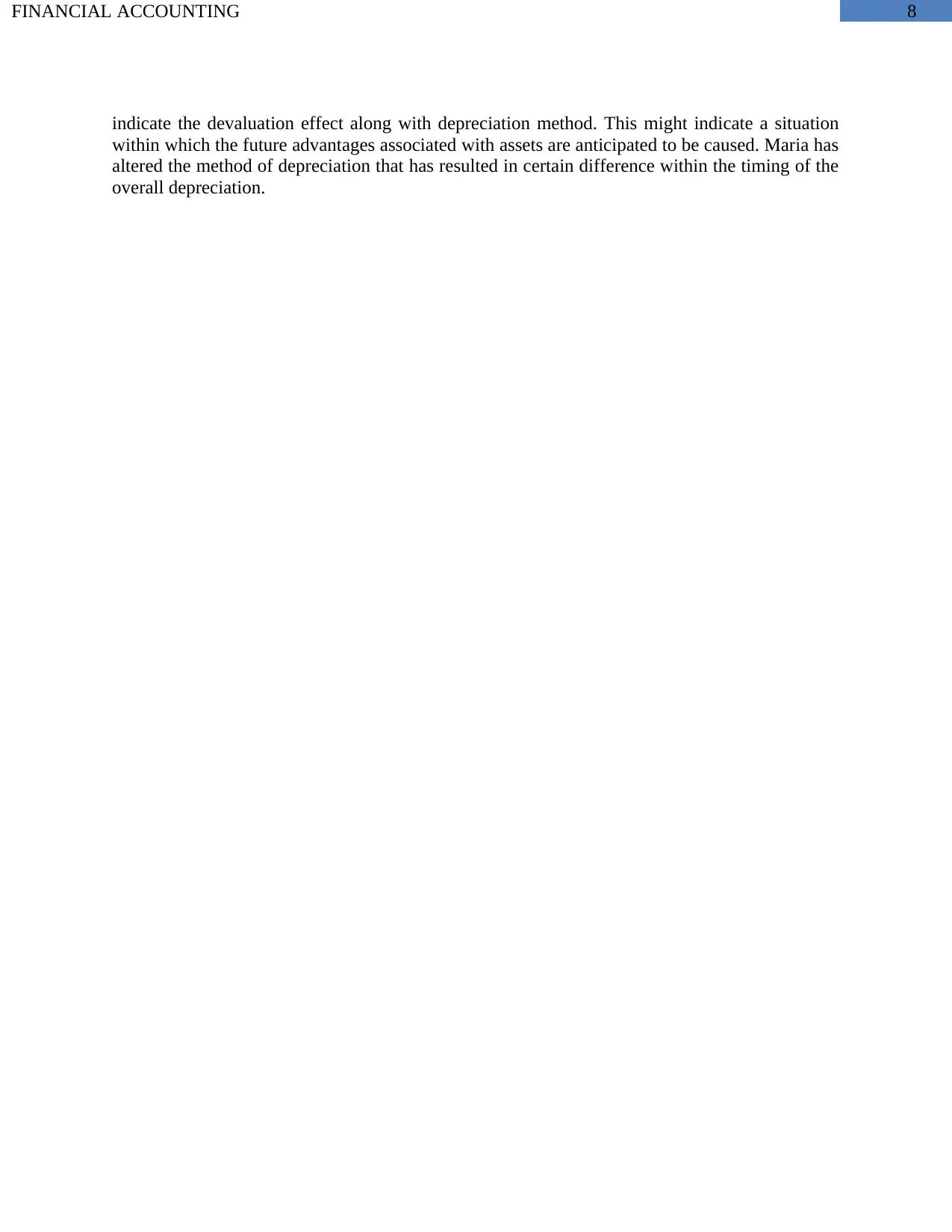
8FINANCIAL ACCOUNTING
indicate the devaluation effect along with depreciation method. This might indicate a situation
within which the future advantages associated with assets are anticipated to be caused. Maria has
altered the method of depreciation that has resulted in certain difference within the timing of the
overall depreciation.
indicate the devaluation effect along with depreciation method. This might indicate a situation
within which the future advantages associated with assets are anticipated to be caused. Maria has
altered the method of depreciation that has resulted in certain difference within the timing of the
overall depreciation.
⊘ This is a preview!⊘
Do you want full access?
Subscribe today to unlock all pages.

Trusted by 1+ million students worldwide
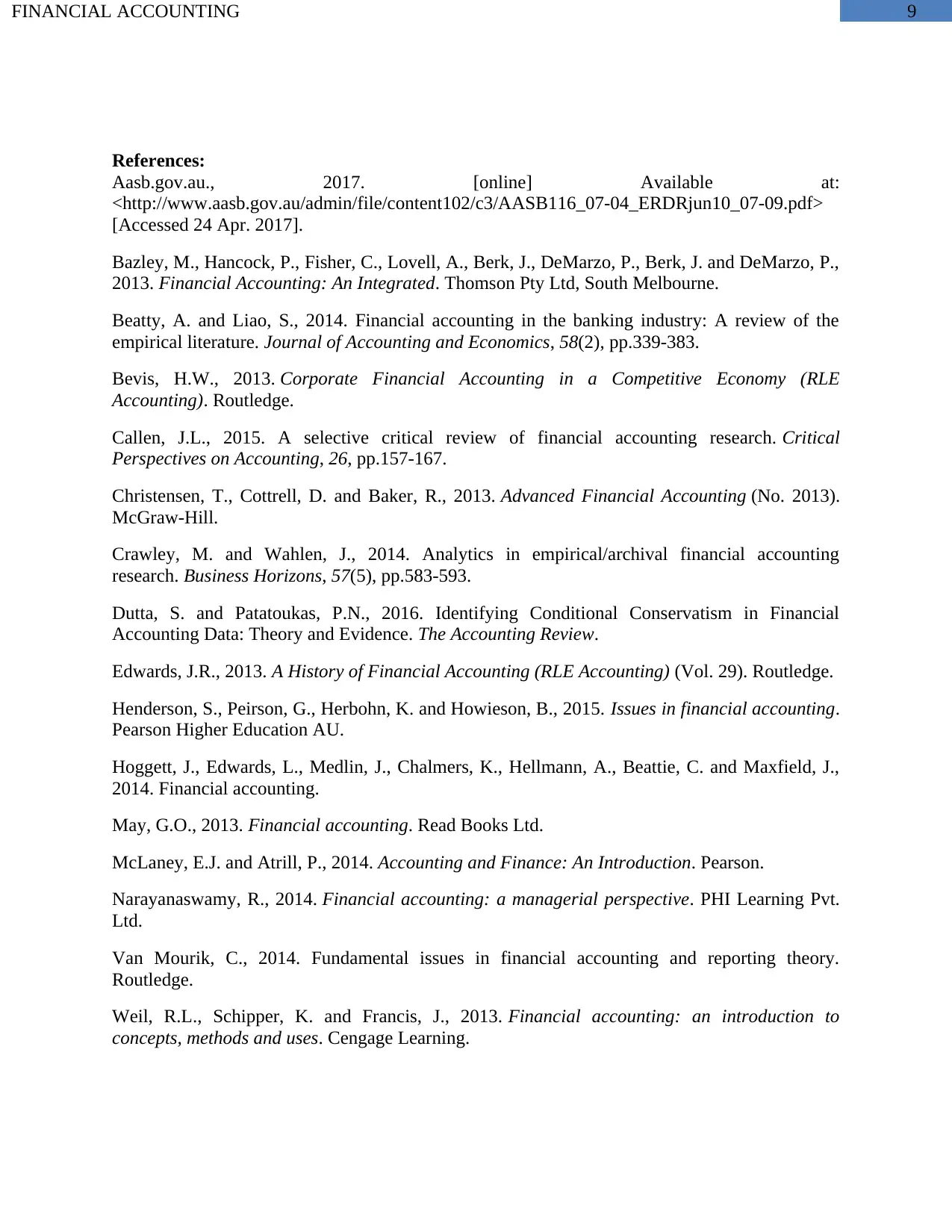
9FINANCIAL ACCOUNTING
References:
Aasb.gov.au., 2017. [online] Available at:
<http://www.aasb.gov.au/admin/file/content102/c3/AASB116_07-04_ERDRjun10_07-09.pdf>
[Accessed 24 Apr. 2017].
Bazley, M., Hancock, P., Fisher, C., Lovell, A., Berk, J., DeMarzo, P., Berk, J. and DeMarzo, P.,
2013. Financial Accounting: An Integrated. Thomson Pty Ltd, South Melbourne.
Beatty, A. and Liao, S., 2014. Financial accounting in the banking industry: A review of the
empirical literature. Journal of Accounting and Economics, 58(2), pp.339-383.
Bevis, H.W., 2013. Corporate Financial Accounting in a Competitive Economy (RLE
Accounting). Routledge.
Callen, J.L., 2015. A selective critical review of financial accounting research. Critical
Perspectives on Accounting, 26, pp.157-167.
Christensen, T., Cottrell, D. and Baker, R., 2013. Advanced Financial Accounting (No. 2013).
McGraw-Hill.
Crawley, M. and Wahlen, J., 2014. Analytics in empirical/archival financial accounting
research. Business Horizons, 57(5), pp.583-593.
Dutta, S. and Patatoukas, P.N., 2016. Identifying Conditional Conservatism in Financial
Accounting Data: Theory and Evidence. The Accounting Review.
Edwards, J.R., 2013. A History of Financial Accounting (RLE Accounting) (Vol. 29). Routledge.
Henderson, S., Peirson, G., Herbohn, K. and Howieson, B., 2015. Issues in financial accounting.
Pearson Higher Education AU.
Hoggett, J., Edwards, L., Medlin, J., Chalmers, K., Hellmann, A., Beattie, C. and Maxfield, J.,
2014. Financial accounting.
May, G.O., 2013. Financial accounting. Read Books Ltd.
McLaney, E.J. and Atrill, P., 2014. Accounting and Finance: An Introduction. Pearson.
Narayanaswamy, R., 2014. Financial accounting: a managerial perspective. PHI Learning Pvt.
Ltd.
Van Mourik, C., 2014. Fundamental issues in financial accounting and reporting theory.
Routledge.
Weil, R.L., Schipper, K. and Francis, J., 2013. Financial accounting: an introduction to
concepts, methods and uses. Cengage Learning.
References:
Aasb.gov.au., 2017. [online] Available at:
<http://www.aasb.gov.au/admin/file/content102/c3/AASB116_07-04_ERDRjun10_07-09.pdf>
[Accessed 24 Apr. 2017].
Bazley, M., Hancock, P., Fisher, C., Lovell, A., Berk, J., DeMarzo, P., Berk, J. and DeMarzo, P.,
2013. Financial Accounting: An Integrated. Thomson Pty Ltd, South Melbourne.
Beatty, A. and Liao, S., 2014. Financial accounting in the banking industry: A review of the
empirical literature. Journal of Accounting and Economics, 58(2), pp.339-383.
Bevis, H.W., 2013. Corporate Financial Accounting in a Competitive Economy (RLE
Accounting). Routledge.
Callen, J.L., 2015. A selective critical review of financial accounting research. Critical
Perspectives on Accounting, 26, pp.157-167.
Christensen, T., Cottrell, D. and Baker, R., 2013. Advanced Financial Accounting (No. 2013).
McGraw-Hill.
Crawley, M. and Wahlen, J., 2014. Analytics in empirical/archival financial accounting
research. Business Horizons, 57(5), pp.583-593.
Dutta, S. and Patatoukas, P.N., 2016. Identifying Conditional Conservatism in Financial
Accounting Data: Theory and Evidence. The Accounting Review.
Edwards, J.R., 2013. A History of Financial Accounting (RLE Accounting) (Vol. 29). Routledge.
Henderson, S., Peirson, G., Herbohn, K. and Howieson, B., 2015. Issues in financial accounting.
Pearson Higher Education AU.
Hoggett, J., Edwards, L., Medlin, J., Chalmers, K., Hellmann, A., Beattie, C. and Maxfield, J.,
2014. Financial accounting.
May, G.O., 2013. Financial accounting. Read Books Ltd.
McLaney, E.J. and Atrill, P., 2014. Accounting and Finance: An Introduction. Pearson.
Narayanaswamy, R., 2014. Financial accounting: a managerial perspective. PHI Learning Pvt.
Ltd.
Van Mourik, C., 2014. Fundamental issues in financial accounting and reporting theory.
Routledge.
Weil, R.L., Schipper, K. and Francis, J., 2013. Financial accounting: an introduction to
concepts, methods and uses. Cengage Learning.
1 out of 10
Related Documents
Your All-in-One AI-Powered Toolkit for Academic Success.
+13062052269
info@desklib.com
Available 24*7 on WhatsApp / Email
![[object Object]](/_next/static/media/star-bottom.7253800d.svg)
Unlock your academic potential
Copyright © 2020–2025 A2Z Services. All Rights Reserved. Developed and managed by ZUCOL.





